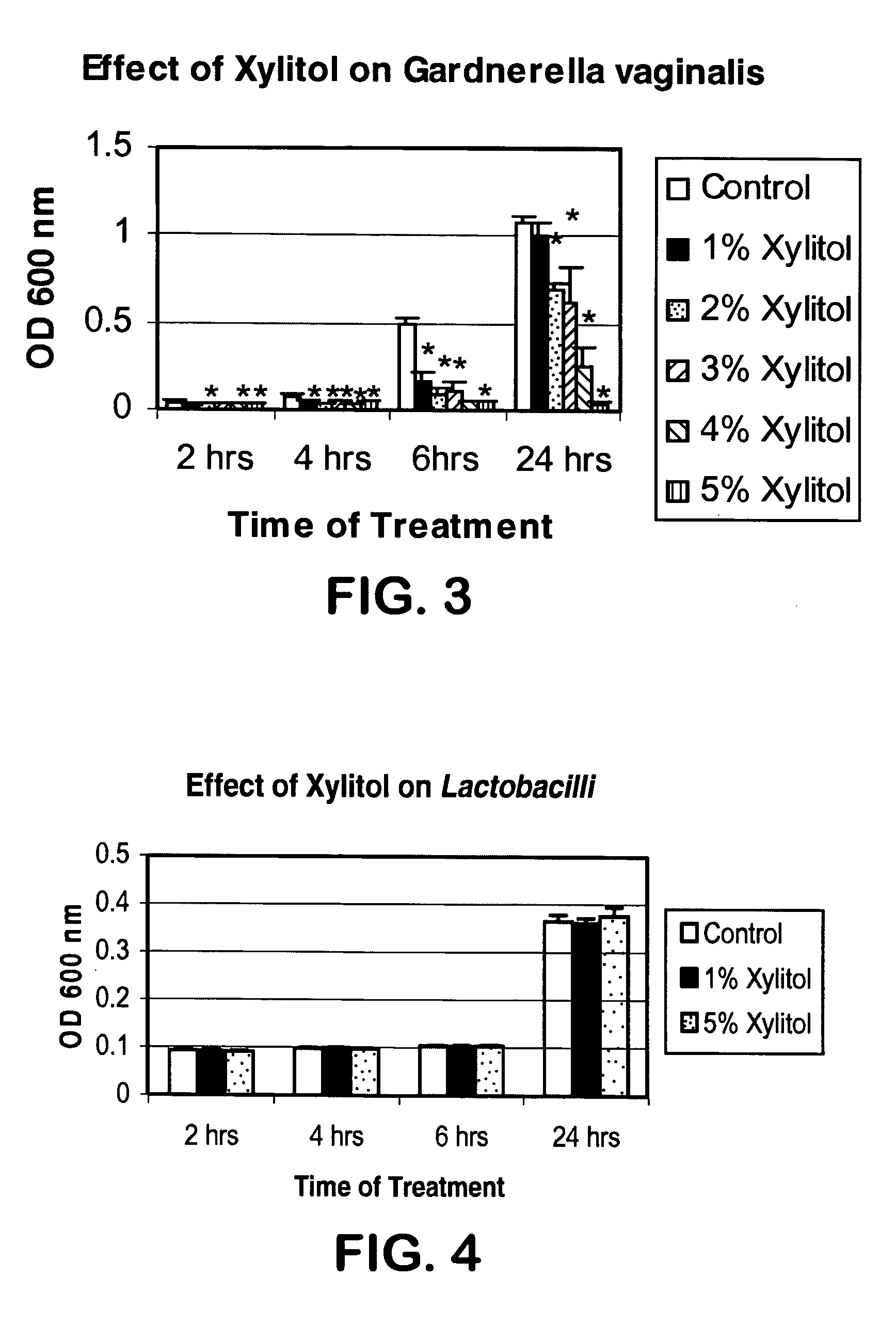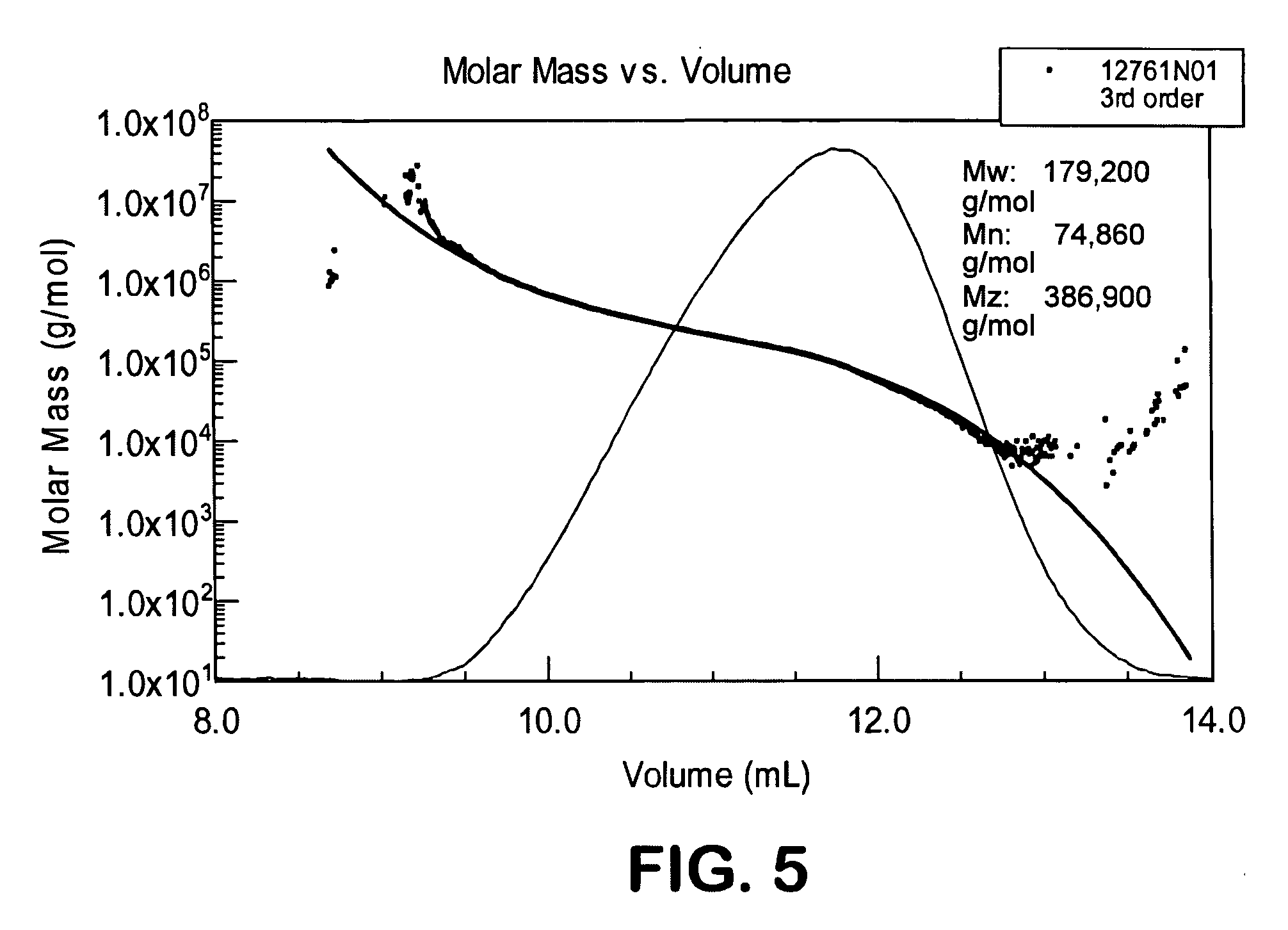Therapeutic agents for inhibiting and/or treating vaginal infection
a vaginal infection and therapy agent technology, applied in the direction of antibacterial agents, drug compositions, biocides, etc., can solve the problems of complicated infection, unfavorable antibiotic use, easy upset of vaginal balance, etc., and achieve the effect of inhibiting and/or treating vaginal infection
- Summary
- Abstract
- Description
- Claims
- Application Information
AI Technical Summary
Benefits of technology
Problems solved by technology
Method used
Image
Examples
example 1
[0065] A microorganism culture of 105cfu (colony forming units) / ml in a 1× phosphate buffered saline (PBS) solution (diluted from 10× PBS LIQUID CONCENTRATE from VWR Cat. No. EM-6507] was used. One milliliter of the solution was plated on proper agar plates, depending on which microorganism was being tested. The agar plates were incubated at 35° C. for 4 hours. Three 4-millimeter diameter wells were then punched in each agar plate. A test sample of 100 microliters of 5% xylitol in sterilized 2-N-morpholino ethane sulfonic buffer (0.1 M 2-[morpholino]-ethanesulfonic acid, 0.9% NaCl, pH 4.7, prepared from BupH™ MES Buffer Saline Pack from Cat. No. 28390, Pierce Biotechnology, Inc., Rockford, Ill.) was added to one well of each plate. Into each of the other two wells were added MES buffer and 1% benzyl quats (diluted from BARDAC® 205M, from Lonza Inc., Fair Lawn, N.J.) as negative and positive controls, respectively. The plates were incubated overnight at 35° C.
[0066] The following da...
example2
[0068] Test compounds were dissolved in culture media to form a suspension. Control or xylitol solutions (0.9 milliliters) were filtered and added into culture tubes, and to this was added 0.1 milliliter of either the Gardnerella vaginalis or Lactobacillus acidophilus suspension at a concentration of around 106 cfu / milliliter. The culture tubes were then incubated overnight at 37° C., whereafter the optical density was measured at 2, 4, 6 and 24 hours by pipetting 100 microliters of the control or sample solutions into 96-well microplates, and then using a ThermoMax Microplate Reader (Molecular Devices of Sunnyvale, Calif.) to obtain the optical density readings at 590 or 600 nm wavelengths. The results are shown in FIGS. 3 and 4. As shown in FIG. 3, xylitol exhibited significant inhibition on the growth of Gardnerella vaginalis as early as 2 hours after treatment. The inhibition effect remained evident throughout the 24-hour experimental period. In contrast, as shown in FIG. 4, xyl...
example 3
[0069] Test compounds were dissolved in culture media to form a suspension. Control or xylitol solutions (0.9 milliliters) were filtered and added into culture tubes. To these solutions, 0.1 milliliter of the Gardnerella vaginalis or Lactobacillus acidophilus suspension was then added at a concentration of around 106 cfu / milliliter. The culture tubes were incubated at 37° C. for 6 hours. The samples in the culture tubes were then diluted at 1, 10 and 100 times, and 100 microliters of each dilution was plated onto agar plates with WASP (Whitely Automatic Spiral Plate) spiral plating equipment from Don Whitely Scientific Limited, USA. The plates were incubated overnight at 35° C., and the numbers of colonies were counted on each plate by either ProtoCol® from Synbiosis, Frederick, Md., USA Whitely Scientific Limited, USA or by hand count. The results are shown below in Tables 2-3 and in FIG. 2,
TABLE 2Effect of xylitol on G. Vaginalis, n = 4Control1% xylitol2% xylitol3% xylitol4% xyl...
PUM
| Property | Measurement | Unit |
|---|---|---|
| temperature | aaaaa | aaaaa |
| temperature | aaaaa | aaaaa |
| temperature | aaaaa | aaaaa |
Abstract
Description
Claims
Application Information
 Login to View More
Login to View More - R&D
- Intellectual Property
- Life Sciences
- Materials
- Tech Scout
- Unparalleled Data Quality
- Higher Quality Content
- 60% Fewer Hallucinations
Browse by: Latest US Patents, China's latest patents, Technical Efficacy Thesaurus, Application Domain, Technology Topic, Popular Technical Reports.
© 2025 PatSnap. All rights reserved.Legal|Privacy policy|Modern Slavery Act Transparency Statement|Sitemap|About US| Contact US: help@patsnap.com



